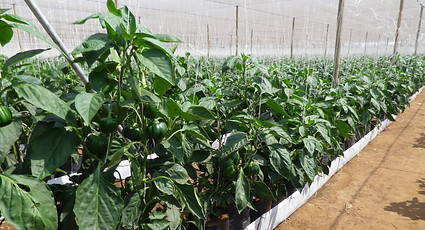



Sunny Shade Sails
Climate Control Shade Net
SpectraNet is the ultimate shade net for climate control and light wave manipulation in the agricultural and horticultural industries.
SpectraNet is well known for providing plant and crop protection against harsh weather conditions and damage caused by hail, wind, insects, birds, drought & sunburn.


The brand name SpectraNet aptly describes the products ability to manipulate and alter the quantity, quality and relationship of blue, green, red and far-red wavelength energies absorbed by plants.
Four fundamental factors that impact on the physiology of plants are:
-
Photosynthesis
-
Photomorphogenesis
-
Transpiration
-
Respiration


High Density Polyethylene
SpectraNet is a knitted shade net fabric, manufactured from “High Density Polyethylene”, high-quality colour concentrates and ultra-violet stabilisation additives.
A well-constructed shade house using one of the many SpectraNet fabrics will enable the grower, to modify or create an ideal protected micro climate in which to produce high quality seedlings, fruit, vegetables, pot plants and cut flowers.
Plants and crops suffer stress from excessive photosynthetic active radiation (PAR), heat, strong winds and UV burn, which generally results in smaller, lower quality yields. Hail, severe storms, insects and birds too, can cause considerable damage to crops.
SpectraNet will provide protection against such calamities, providing an environment for optimum growth and yield. It ensures good air circulation, with excellent moisture exchange resulting in large savings in water and chemical sprays.
SpectraNet Protects Crops
SpectraNet plays a major role in all these areas, by manipulating and altering the quantity and quality of photosynthetic active radiation energy absorbed by plants. Photosynthesis is driven by temperature, light intensity, light quality, light duration, carbon dioxide quantity, water quality and nutrients in order to produce energy (sugars) for plant growth and food production.
Photomorphogenesis on the other hand is light-mediated changes in plant growth and development. The size, shape and appearance of a plant are influenced by the relationship of blue, green, red and far-red wavelengths absorbed by the plant.
SpectraNet’s light transmittance factors vary from 4% to 96% dependent upon colour and pattern of the netting.



Lock-Stitch Pattern
The SpectraNet lock-stitch pattern, obtainable through a knitted construction, means the fabric will not fray or unravel when cut. The mesh size governing the shade percentage is fixed or locked in place, making it impossible for it to be altered.
Due to its knitted lock-stitch pattern, SpectraNet allows easy joining and repairing should the fabric be accidentally torn.
Salient features of SpectraNet are:
1 A knitted lock-stitch pattern forms an integral part of the design of SpectraNet, which:
-
ensures that the mesh configuration is consistent and stable;
-
prevents laddering;
-
prevents unravelling;
-
is flexible and easier to work with;
-
makes repairing insitu easy; and
-
“breathes”, thus preventing hot air being trapped.
2 SpectraNet is used to protect plants and crops against:
-
sunburn;
-
hail damage;
-
wind damage; and
-
birds and insects.
3 SpectraNet creates a better climatic environment for plants to grow by:
-
reducing temperatures;
-
maintaining humidity;
-
reducing evaporation;
-
reducing stress;
-
enhancing photosynthesis;
-
improved light dispersion; and
-
positively affects the photomorphogenesis of plants.


4 SpectraNet is durable and tough:
-
does not rot;
-
does not absorb water;
-
is not considered a fire hazard; and
-
is ozone friendly.
5 SpectraNet quality:
-
carries the prestigious SATAS Certification mark for product quality management; and
-
comes with an 10 year manufacturer’s warranty against UV degradation.

